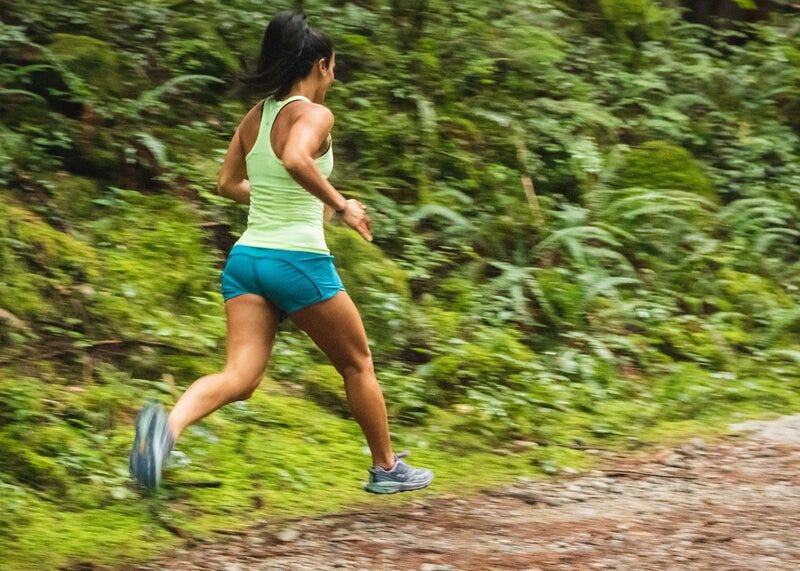We’re running Richmond this fall!
Join us when we get together in person to run the Richmond Half Marathon in Richmond, Va., on November 11, 2023 — and, add yourself to ‘The Half Marathoner Newsletter’ group during the signup process. Can’t wait to see you there!
“I needed to find out if I was intrinsically motivated enough to put in the work when I was in charge and no one was watching. If I skipped a day or week of running, nobody would know, comment, or be invested. If I bailed when a session began to get difficult, I was accountable only to myself. I’d always had an easy answer for How badly do I want this? Unearthing the reasons behind that desire and taking them with me every day was a more complicated endeavor.”
— Des Linden, Choosing to Run
Confession time: whenever I sit down to write this newsletter, there’s always a part of me in the back of my mind that doesn’t feel quite up to it. That I’m not actually the person who ought to be writing to you, that surely there’s someone more experienced, more qualified — more something — who should be here, talking with you.
And I feel the same way just about every time I go for a run — at least the runs I do outside among people, and not at home on my treadmill. Especially when I pass by runners who are fitter and faster than me (or, more accurately, when they pass me), little thoughts start to float around in the back of my mind, asking me if I’m kidding myself being out here.
Thankfully, those thoughts melt away after a few moments and I’m back with myself again; moving my body and exerting myself seems to do the trick of pushing those negative thoughts back where they came from. And when I start to sweat, I’m really alone with myself, mentally clicking off the miles as the rest of the world fades into the background.
Over the weekend, I picked up a pair of books that I’ve had on my bookshelf for a while: Choosing to Run, the memoir released last year by 2018 Boston Marathon winner Des Linden; and another simply titled Running, by Lindsey A. Freeman, an associate professor of sociology at Simon Fraser University, for whom running has been a pursuit and a passion her whole life.
The latter book, especially, puts into words so many of the thoughts I’ve had about running over the years, but never could exactly articulate — everything from why we do it at all to what it means to me individually, from the sweet feeling of exhaustion at the end to the pleasure of feeling fully present and in the moment inside one’s body, moving to a rhythm that’s all our own.
When looking back to what inspired her to run in the first place, Freeman delightfully shares something that I’d bet has been an inspiration to you also: from Chariots of Fire to Rocky IV, she writes, “I was raised on sports movie training montages”:
“Through the films of my youth, I was socialized to love and fetishize practice nearly as much as winning, maybe more so. I remember the English and Scottish runners dressed in white Henley shirts and shorts to their knees, barefoot on the sand, full of joy, training in the surf, from Chariots of Fire…
Montages like these still stick with me even when final cinematic knockout scenes and Olympic podium denouements can no longer be recalled. The rhythm of a typical sports movie montage lights up a pleasure center laid down in my memory, and I would live inside this cadence if I could.
The predictable cycle goes like this: an athlete overcomes multiple setbacks; slowly their body bends to and with the monotony, agony, and ecstasy of practice; and then all that practice gathers up and we can see everything come together, and just when the athlete needs it to! Montages are a surefire method to open me up to the imagination of possibility through practice.”
Montages like these and the memories of them we carry through our lives aren’t silly or insignificant, Freeman writes. Far from it, actually — they help us to mentally leap through time so we can imagine ourselves in the characters we see on the screen; our challenges, our joys, our frustrations play out in what they go through. When they overcome, they show us the way we can too, even if only in small ways the rest of the world never discovers.
That’s what is happening as I read Choosing to Run too, even though I’m (obviously!) not anywhere close to the same dimension, ballpark or planet as Des Linden when it comes to running. The book is an intimate look into her running life and career, alternating between chapters that describe her Boston win in an almost moment-by-moment fashion, and others that zoom out to tell us the story of her life, reaching back to her childhood and formative years as a collegiate runner.
One of my favorite chapters is “The Right Why,” in which Linden writes about a pivotal moment when she decided to leave the Hansons running team she’d been a part of since the start of her career as a professional runner — which meant leaving behind all their structure and coaching, and to find out what she could create for herself.
The process took time (and coping with some serious health issues), but what I find so interesting are the passages in which she shares how she found her way to a new sense of who she was as a runner, and as an individual:
“There were also times when I reconnected with [my former] community in a way that reminded me why I appreciated the act of running, as opposed to competing. Kate Gustafson, a Canadian I’d met while training in Kenya, reached out and said she was headed to a running retreat in Tempe. She and I shared a passion for travel, and we always tried to get together when we randomly found ourselves in the same place.
We picked up the conversation without missing a beat, as usual. She and her group of friends weren’t professional runners, but their passion for the sport was contagious, and the dust they kicked up in Phoenix reeled me back to my time in Iten. They were dedicating themselves to strive for personal bests without the tangible goal of a major title or commercial benefit. It was a good shake-up for my perspective. Running wasn’t just about comparison to others. It was internal: me versus me, a continual self-measurement I relished.”
I’ve bolded those last couple of sentences because I know I need to remind myself of them too. In contrast to someone like Linden, no one watches what I do when I run — which means the numbers, data, etc. that I generate with my watch and my phone, they ultimately don’t matter (even though I probably pay them way more attention than I should).
What matters is the work I put into it, the experience I get to have while doing it. As Linden writes, “I knew my good days weren’t making the world turn, but I did have the sense I was in sync with the world as it turned, using gravitational pull instead of letting it use me, moving with a sense of purpose. It felt like this was what I was a hundred percent built, wired, and designed to be doing — not forever, but there and then.”
These words are powerful for me right now, especially as we move now into the part of our training schedule where the number of miles starts to go up; it can start to feel a little overwhelming, especially if we’ve fallen behind on a few of our runs in the weeks just past.
When I think about all that’s ahead, I try to take a breath and remember just to focus on the here and now, what’s right in front of me. Let’s scale that mountain first, and then we’ll worry about all the rest.
How about you? How is your training going, especially if you’re following our plan — or your own? As always, keep in touch and let me know how your running/life is going 😃
Your friend,
— Terrell
Our training miles for this week
How did your seven-mile long run go this weekend? For me, this was the longest distance I’ve run in a long time, or at least as long as I can remember. I ran it on my treadmill — which, yes, is easier — but only because we’ve been experiencing some serious heat here where I live in Atlanta; temperatures hung around the upper 90s for most of the weekend. Still, seven miles is seven miles — I’ll take it!
Here are our miles for this week:



